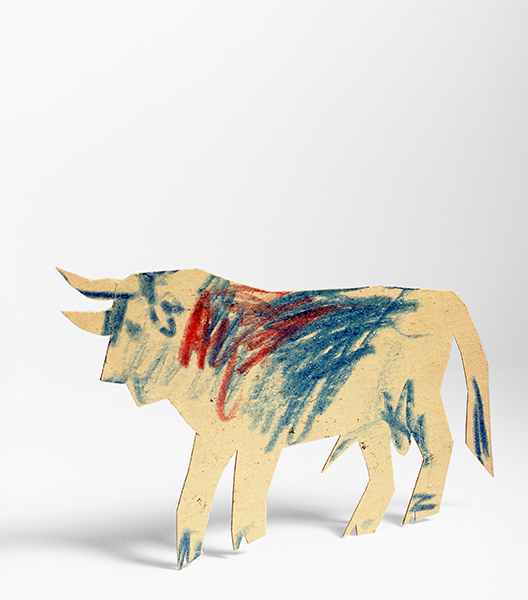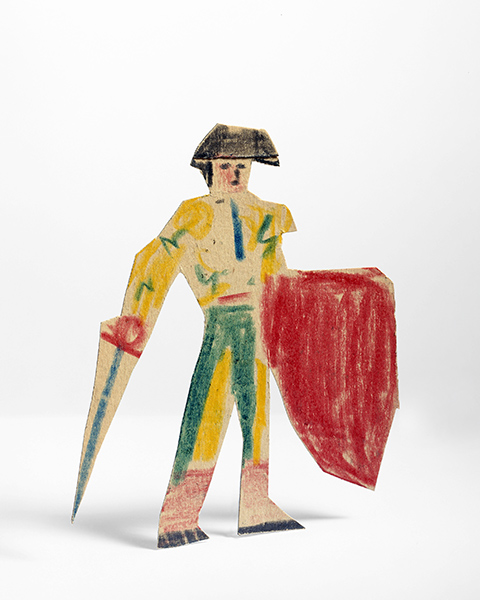"The toy is or is not a work of art based on the hands of the one who has achieved. "
B. G.: Were certain things expected of you?
Nothing was asked of us and we never asked anything of them. When you have the example of someone who, to put it superficially, tinkers, you also tinker, you make things, you figure things out on your own. You may not achieve the same result, but the point isn’t to produce a masterpiece. A masterpiece isn’t the main concern. What’s important is doing, going out on a limb and saying, “Let’s do it.” You have to take risks and accept the consequences. That’s what I learned. Without becoming a reckless idiot, it allows you to face the bull, the monster, and pleasure, to face whatever comes your way. It gives you a certain confidence in dealing with life.
B. G.: What we now may view as cutout sculptures, were they really considered toys back then?
It’s really quite funny, like the bit with the toy car. Obviously at the beginning they started out as toys, but then they became increasingly elaborate. Then my mother had to knit clothes for the doll and in the end it looked so good that they couldn’t let Paloma ruin it. So they set it aside.
There were always things like that, an idea would start to develop and gradually acquire density. Sometimes he would make a break and shift into a different direction.
The idea of making a toy was originally well-meaning, but then it headed in a completely different direction. I don’t remember being particularly upset by it. There were all those creative moments, the process, Françoise knitting, the wood carving, bad wood to boot. It was never good wood. He had tried carving boxwood, which is frightfully hard, and it went on forever. After that he started using whatever was at hand: pieces of cardboard, string, nails, whatever.
I would like to add that in the case of the toy car, the idea stopped there. Whereas the dolls, there was one, then two, then three, and then it became very elaborate. For the car there was that idea of using Evian bottle caps for the wheels, and that was it, no more. Actually, yes, I tried to do some drawings of it, but…
A toy is or isn’t a work of art depending on the hands that made it.
Picasso’s an artist, an important artist, so we take a closer look at what he did, what his hands made. It’s a bit unfair for all the people who make toys out there.
B. G.: But the dolls are related to the assemblage.
As an art historian you would consider them assemblages, some of the major artworks of the second half of the 20th century. And really, they were just dolls.
B. G.: However, you say that Picasso himself thought the toys had crossed that boundary?
He viewed himself much like an art historian would. At a certain point he would cross a narrow border and everything would shift. At the beginning it was a pastime, like ceramics, and then he pushed it further, tightened the screws, and stepped into a different dimension. The fact is that it’s interesting precisely because it’s Picasso.
B. G.: For example, the horse he made for Bernard was also a sort of starting point for his work with Prejger.
It started with a very slight intervention by Picasso, if you could call it that, and right away it shifted into something new. The loveliest materialization of this long story is the chair that recalls the large-format early cubist still life collages. So he went back to the beginning.
In fact, every time that Picasso stumbled, he picked himself up again with sculpture, it’s really incredible. He returned from Horta and sculpted the head of Fernande, it was a hiatus.
It blows up the wall between a before and an after. Is the sculpture truly extraordinary? In any case, it plays a key role, it brings the house down, breaks the sound barrier. And there you go, flying at Mach 2. Accidents happen, and that’s what’s interesting.






 Summary
Summary